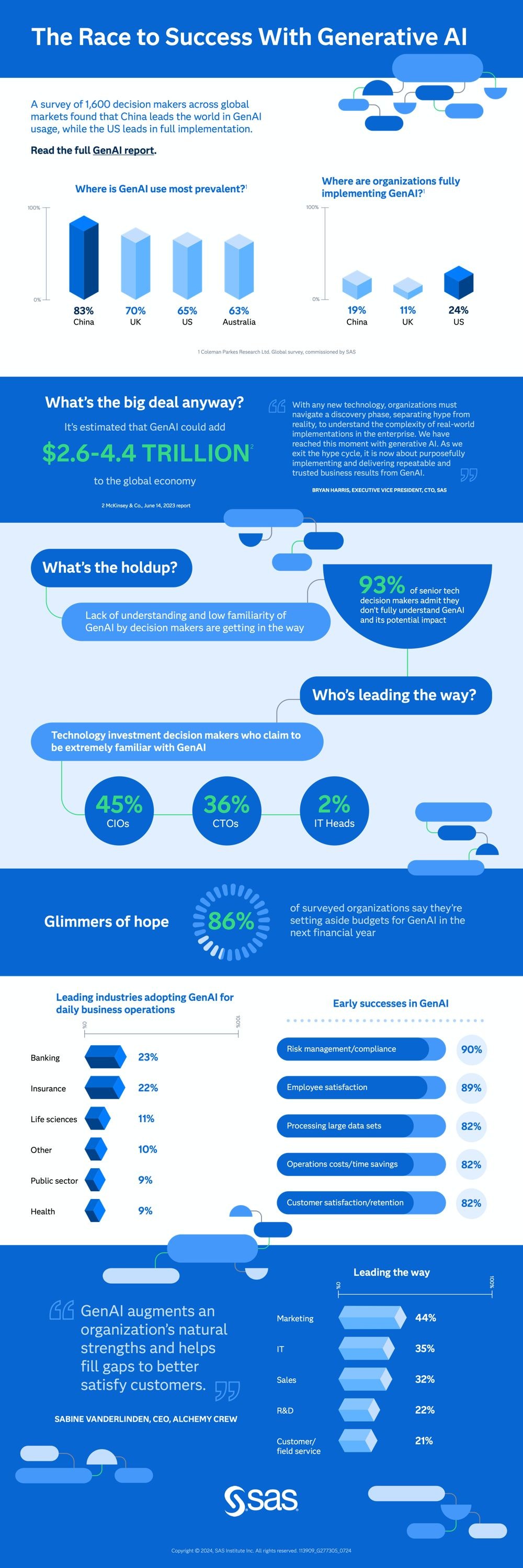SEARCH
Global Market Research: China leads the world in the use of GenAI

SHARE IT
Productive artificial intelligence (GenAI) is here to stay. Organizations around the world are using it and are enthusiastically investing in it. But which regions and countries are leading the way in the use of GenAI? China leads the way, according to a recent global study by SAS commissioned by Coleman Parkes Research Ltd. Business decision makers in China report that 83% of their organizations use this technology. This is higher than the UK (70%), the United States (65%) and Australia (63%). However, organisations in the United States are ahead in terms of full deployment and have fully implemented GenAI technologies at 24% compared to 19% in China and 11% in the UK.
What does this mean in terms of the global economic impact of AI and GenAI? In a 2023 study, McKinsey estimated that GenAI could increase global economic output by $2.6 - $4.4 trillion each year through various applications. This amount is comparable to the UK's total GDP in 2021 and, the impact could increase the overall impact of AI by 15 - 40%.
With these financial implications in mind, SAS and Coleman Parkes surveyed 1,600 decision makers in key global markets. Respondents came from a variety of industries including banking, insurance, government, life sciences, healthcare, telecommunications, manufacturing, retail, energy and utilities, and professional services. The smaller organisations surveyed employ a workforce of between 500 and 999 people, while the larger organisations employ more than 10,000 employees.
Stephen Saw, CEO of Coleman Parkes, said, "While China may be leading the way in GenAI adoption rates, higher adoption does not necessarily equate to effective implementation or better performance." He concluded by saying: "In fact, the US is leading the 'race' with 24% of organisations having fully implemented GenAI, compared to 19% in China."
Regions worldwide are making progress with GenAI
Highlights from the global survey results include indicators that suggest different regions are beginning to adopt GenAI in meaningful ways, but at different rates.
"As with any new technology, organisations must first go through a discovery phase, separating hyperbole from reality, to understand the complexity of real-world applications within the enterprise. We've reached that point with production AI," said Bryan Harris, Executive Vice President and Senior Technology Executive at SAS. Still, he added: "As we move beyond the excitement phase, the challenge now is targeted implementation and delivering repeatable and reliable business results from GenAI."
Industries and business units are embracing GenAI at different rates
Sabine VanderLinden, CEO and Venture Partner of Alchemy Crew, sees a lot of potential for industries investing in GenAI. In conclusion, she pointed out: "The future of business is being reshaped by GenAI. Indeed, integrating GenAI into business processes - from personalized advertising to marketing to precision insurance claims - offers unique opportunities for efficiency, personalization and strategic forecasting. The adoption of this technology is essential to enable businesses to stand out in a highly competitive and ever-changing marketplace."
When breaking down the data by industry sector, it appears that banking and insurance lead other industries in terms of integrating GenAI into day-to-day business operations across a wide range of metrics.
Early adopters of GenAI face many barriers to its use and implementation
No. 1 on the list of challenges organizations face when using GenAI in day-to-day use is the lack of a clear strategy for it.
Only 9% of leaders who responded to the survey claim to be particularly familiar with adopting GenAI in their organization. Of those respondents whose organizations have fully implemented GenAI, only 25% report that they are particularly familiar with their organization's GenAI adoption strategy. Even decision makers involved in technology investment decisions are still not very familiar with AI - including those in organizations that are ahead of the adoption curve.
Nine out of ten senior technology decision makers admit they do not fully understand GenAI and its potential to impact business processes. At 45%, chief information officers point the way to executives who understand their organisation's AI adoption strategy. However, only 36% of senior technology executives say they are fully aware.
Despite this gap in understanding, 75% of organisations report that there is a provision for investment in GenAI in their budget for the next financial year.
Other challenges facing organisations include:
- Data
As organizations adopt GenAI, they realize that they do not have sufficient data to improve their large language models (LLMs). Additionally, they realize - when they see in-depth development - that they do not have the right tools to successfully implement AI. IT leaders in organizations are mostly concerned about data privacy at 76% and data security at 75%.
- Operating regulations
Only a tenth of organisations report that they are fully prepared to comply with upcoming AI regulations. One-third of organisations that have fully implemented them believe they can comply with the regulations. Only 7% provide a high level of training on GenAI governance, while only 5% have a robust system for measuring bias and privacy risks in LLMs.
Although there are barriers, some early adopters have already experienced significant benefits: 89% report improved employee experience and satisfaction, 82% report operational cost savings, and finally 82% report higher customer retention.

MORE NEWS FOR YOU

 Help & Support
Help & Support 

